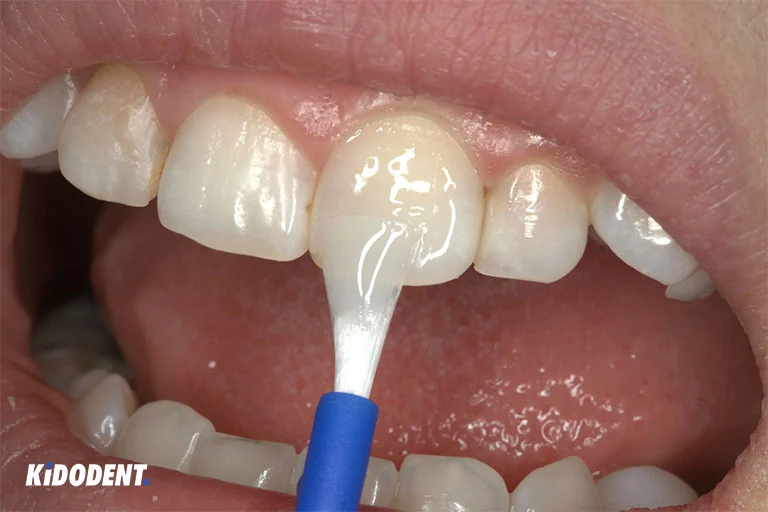Fluoride is a natural mineral that helps strengthen tooth enamel and reveres the early stages of tooth decay. Known as nature’s cavity fighter, fluoride is highly effective in preventing teeth from getting decayed especially among children. If you or your child are at risk of tooth decay or your dentist has advised you to do fluoride treatment (therapy), you need to read this article. Here, we define fluoride therapy, its application, recommended levels, benefits, and side effects. This information will be useful to know.
What is fluoride treatment?
Fluoride treatment, also called fluoride therapy, is an in-office treatment in which fluoride is applied professionally and usually in higher concentrations on your teeth. The treatment can be done by a dentist or a dental hygienist to increase the decay resistance of teeth or help rebuild lost minerals in teeth.
To do this simple preventive procedure, the dentist involves cleaning the teeth surface with a special toothbrush and toothpaste and then applying the fluoride gel or varnish onto the surface of the teeth. After that, the child shouldn’t eat anything for half an hour until they wash their mouth for the perfect absorption of the fluoride to the teeth.
Fluoride therapy can also be done for adults, and it is a common treatment for children and adolescents done by pediatric dentists.
When is the best time to do fluoride treatment?
As we mentioned above, fluoride treatment is done for children and adolescents, but it can be used for adults, too.
- As an example, children under 6 can benefit from fluoride therapy for protecting both their baby (primary) teeth and their permanent teeth
- For children between 6 and 16 years old, fluoride therapy acts as a protective way for permanent teeth ( especially for molar teeth that are at the beginning of development and are at high risk of tooth decay)
Dentists usually advise their patients, depending on their oral health conditions, to practice fluoride therapy regularly every 3, 6, or 12 months.
Fluoride treatment in case of high risks of tooth decay
If your teeth are more prone to tooth decay conditions, the fluoride gel is prescribed to be used regularly at home. The following habits can increase the risk of tooth decay:
- Alcohol and drug addiction
- Bad eating habits
- Poor oral health
- No professional dental caring
- Unhealthy diets
- Dry mouth and low saliva flow
What are the advantages of fluoride treatment?
Adds minerals to our teeth
There are detrimental effects when there is too much acidity in your mouth and this acidity is harmful, especially for children. The produced acid in your mouth can damage the structure of the teeth (like calcium and phosphorus) and weaken the enamel.
Luckily, fluoride can prevent the damage caused by the acid. It adds minerals that contribute to the remineralization process of the teeth.
It is economical and reduces future dental costs
Generally, preventive treatments can reduce dental costs and time.
Fluoride and products containing fluoride are not really expensive and help you with your medical expenses. We can use fluoride in both topical and systemic ways to prevent tooth decay or other dental problems.
Topical fluoride, including toothpaste, mouthwash, and dental treatments, work by direct application of fluoride on the surface of the teeth. Systemic fluoride includes all those ways that fluoride is ingested, like drinking water, which is normally fluoridated, and also other foods and beverages that we consume. A pediatric dentist might also recommend fluoride supplements to your child in case of fluoride deficiency risks.
Fluoride is natural and has inhibiting effects
There are other decay-resistant ways available, but not all of them are natural. For example, you can name pits and fissure sealants as a useful procedure, which seals the pits or cracks on the chewing surface of the teeth to prevent tooth decay.
Fluoride naturally exists in the oceans and groundwater. Even if you don’t do fluoride therapy, you can obtain some levels of that in the natural resources.
In the community water systems, some recommended levels of fluoride are added to the water. By the way, whether you get fluoride from natural sources or throiugh fluoride therapy, it is the best and the cheapest preventive treatment that you can benefit from.

What are the side effects of fluoride treatment?
Dental fluorosis is the most common side effect of fluoride. It occurs because of long-term too much fluoride ingestion during teeth development years. Therefore, it is recommended that children under age 8 be protected from exposure to too much fluoride. This is why dentists use lower fluoride concentrations and safer dosages in fluoride treatment aimed at children.
In addition, parents should supervise children’s toothbrushing and provide them with toothpaste containing a smaller amount of fluoride. In some rare cases, the high dosage of fluoride causes fluoride toxicity (it is rare but better to be informed). There are other side effects because of high levels of fluoride, like bone growth disorder among children.
A high dosage of fluoride can have these side effects:
- Stained permanent teeth
- White spots on the teeth
- Homeostatic bone problems
- Other bone problems
Sometimes, with high levels of fluoride supplements in tablets or other medication, some severe forms of toxicity appear and the symptoms are:
- Nausea
- Diarrhea
- Fatigue
- Excessive sweating
To prevent this, parents must keep dental products or fluoride medications out of the reach of young children.
